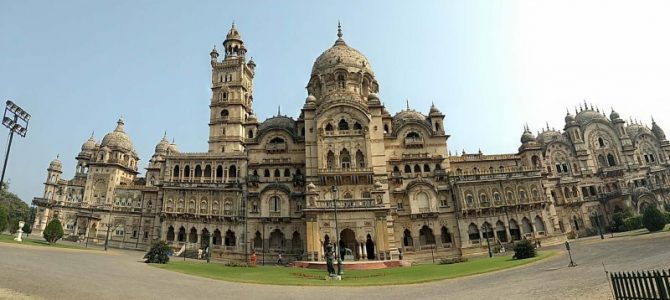Which city of India has a major financial bank named after it? It is in the west of India and flourishes by the banks of the Vishwamitri river. It is named after the Sanskrit word for a banyan tree. In fact, the emblem of the city is a banyan tree. The British named the city something other than its original name and that English name is more famous. The city is the second most important city in the state of Gujarat. It also has the second most important railway station in the Western Railway behind Mumbai. The name is Vadodara, while the anglicised name is Baroda. The city is the home to the Bank of Baroda.
History of Vadodara
Vadodara was called Chandanvati during the time it was ruled by the Rajputs. The town passed hands to the Gupta dynasty, then to the Muslim Siddi rulers, to the Mughals, to the Gaikwads of Maharashtra, till the British overpowered the incumbent rulers and established the city as one of their financial and trade hubs. To connect the city to their most important port, Mumbai, they started the Bombay – Baroda railway, which today is called the Western Railway, starting from Churchgate in Mumbai and ending at Madhya Pradesh’s Ratlam. The western railway and the usage of Mumbai port gave impetus to the industries of Vadodara. While every ruling dynasty left some footprint on the city, the biggest ones are left by the Maratha Gaikwads and by the British. However the origin of the name ‘Vadodara’, which refers to the huge trunk of a banyan tree, have been lost in history.
Baroda was previously a kingdom, adjoining the Bombay presidency. During 1949 – 50, the presidency was stripped of its royal status and was incorporated as a district in the newly formed state of Gujarat. Boundary lines between the Bombay presidency and Baroda presidency were totally redrawn to form the new states, Maharashtra and Gujarat, based on the concentration of people speaking Marathi and Gujarati languages.
Geography of Vadodara
Gujarati-speaking Vadodara is situated on the fertile zone between Mahi and Vishwamitri rivers. The smaller Vishwamitri river flows right through the city, whereas the larger Mahi river flows to the north-west. Both rivers join the sea at the Gulf of Khambat, which is a natural division splitting the state into east and west. To the east of the Gulf is the highly developed Gujarat, where the Indian peninsula starts and continues all the way to Kanyakumari. The NH-8 Mumbai – New Delhi highway and the mainline of the Western Railway are to the east of the Gulf too. This region also has other important cities such as Valsad, Navsari, Surat, Bharuch, Anand, Nadiad and Ahmedabad. The state to the west of the Gulf is the dry, a part of Gujarat still to be developed, but still has important cities like Rajkot, Bhuj, Bhavnagar and Jamnagar.
Vadodara is also the administrative headquarters of the district of the same name. The city is only 110 km from Gujarat’s most important city, Ahmedabad. The town of Anand, which is famous for AMUL dairy is between Vadodara and Ahmedabad, about 40 km away from the former.
Here are the best places to see in Vadodara.
Lakshmi Vilas Palace
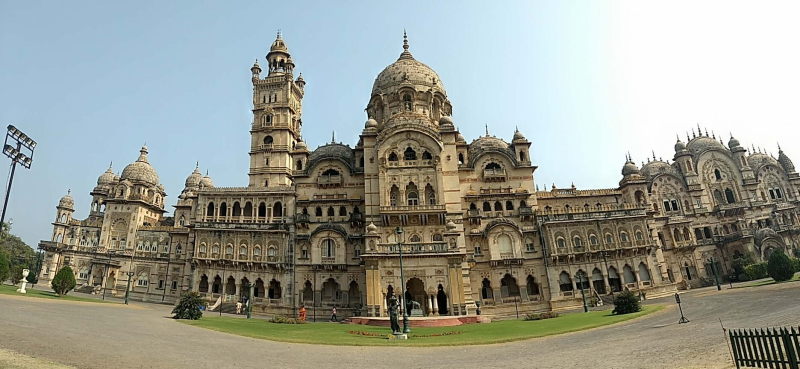
The Lakshmi Vilas Palace, locally called the LVP, is the house of the royal Gaikwad family. The family still lives there.
This magnificent edifice belongs to the Gaikwad monarchy and even today the latest crown prince resides there. The rooms of the royal family in the higher floors of the palace are off-limits for the public, but the ground floor and the lawns are part of a museum that is a popular tourist destination. When you purchase tickets for the museum, you are given a portable MP3 player and headphones. Each place of interest in the palace and its grounds is marked with a number that forms a sequence. The MP3 player plays a guided audio tour with commentary corresponding to each of the numbered places. It starts from the palace’s open-air amphitheatre, then the exterior of the palace, then the lobby, working its way inside until you get to the opulent Darbar Hall, that used to be a venue for performing artists. Even today, the Hall is used exclusively by the royal family and dignitaries for hosting exclusive performances. There are several paintings, carvings and stonework on the walls of the palace. It is a fully worthwhile experience to visit the house of the royal family in Vadodara.
Raja Fateh Singh Museum

The Fateh Singh Museum houses the art collection of the Gaikwads
This museum has several galleries across two floors. During their rule over Vadodara, the Gaikwads patronised various art forms and commissioned several artists for masterpieces. This museum is a repository of the richness of art forms enjoyed by the Gaikwads. Paintings, woodwork, sculptures, board games and several other forms of art draw your attention to them. Though not very big, the museum takes quite a long time to complete seeing all the interesting art. Outside the museum, we saw other exhibits like the miniature of a Flying Scotsman steam locomotive.
Sayaji Baug
At the centre of Vadodara is the city’s favourite recreation ground. Little wonder that the citizens flaunt this huge place to their guests. The word Baug means a garden, but once you go inside, you see a whole world. In fact, one of the attractions inside the park can show you the universe! A planetarium that airs 3D shows regularly in Gujarati, Hindi and English.

Sayaji Baug is Vadodara’s own promenade and convention centre.
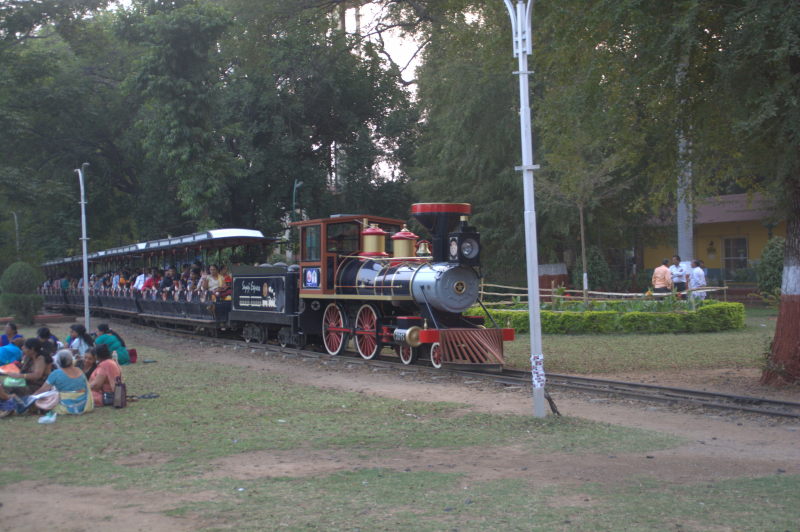
Toy train inside Sayaji Baug.
The park itself is divided into several manicured lawns with floral patches and seats for relaxing. A toy train circumvents the park and is thronged by children and adults alike. The park gets denser in greenery towards the centre where it ends in the Sayaji Zoo. This is a showcase of birds, big cats, monkeys and reptiles.
There are two museums inside the park. One of them is a Health Museum, which showcases exhibits from the world of health care. Most of the exhibits display how different organs in the body work. There is a small baby doll model that can toddle on the ground and move its eyes.
The second museum is the Baroda Museum, that has a staggering collection of historical artefacts from around the world. There are displays of art work, handloom and rich possessions from several parts of India. There are other dedicated galleries such as Egypt gallery. It takes close to three hours to see this museum fully and you are recommended to spend half a day or more at Sayaji Baug.
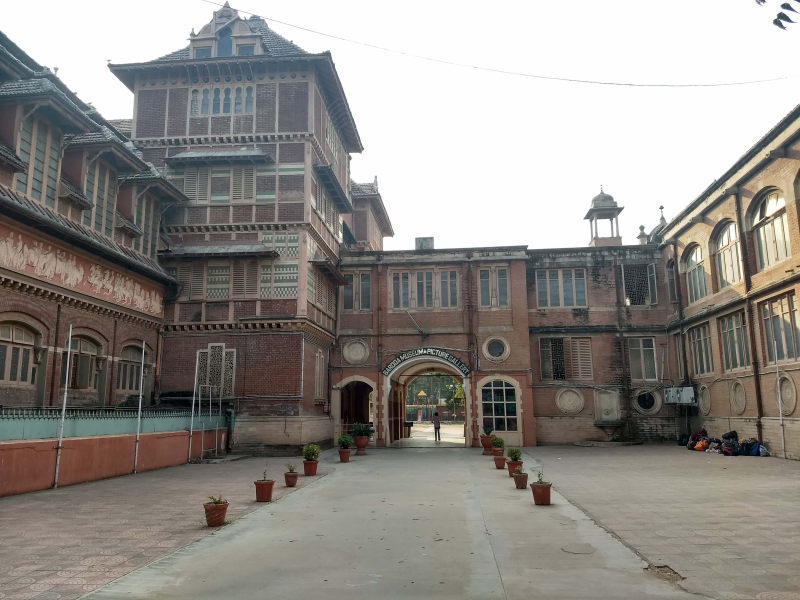
The Baroda Museum can require upto 3 hours to cover.
Food isn’t a problem if you want to spend your day here. The Baug has two huge food courts with public facilities.
Sur Sagar lake
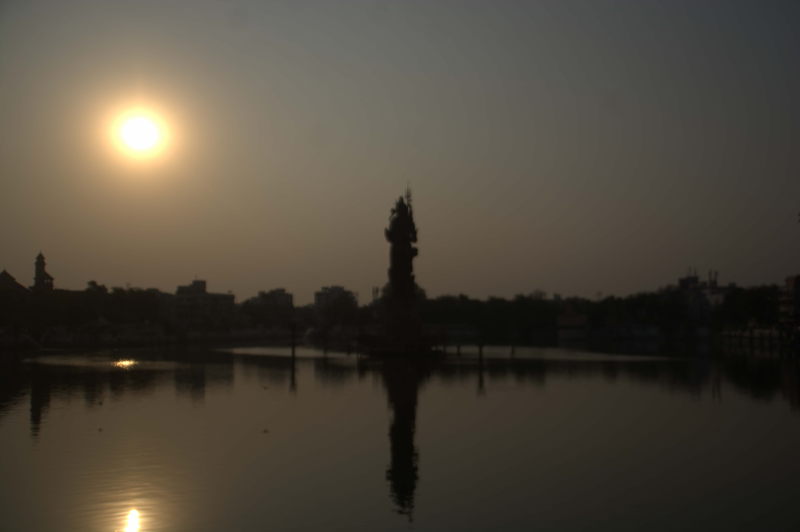
Sunset time near Sur Sagar lake.
In an old part of Baroda, near the district court, is a lake called Sur Sagar. It has a huge statue of a standing Lord Shiva. On the banks of the lake, apart from the British-built court building, are two interesting features. One is the small market named the Padmavati market, which is good for eating street-food and low-cost shopping of clothes. Another attraction is the Lehripura gate, a Muslim structure built during the Sultan rule in Gujarat, reminding you of similar gates in the Charminar area of Hyderabad. As the city expands, the gate stands the testimony of time.
Tambekar Wada
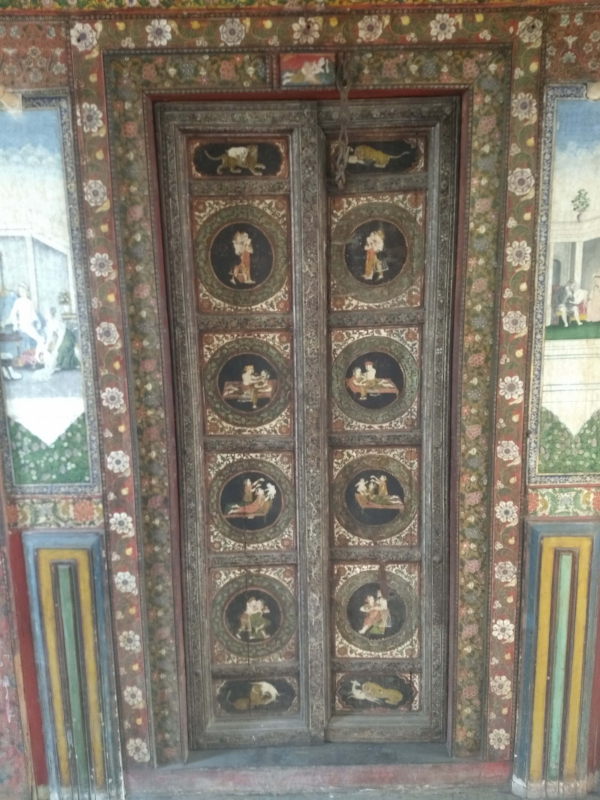
An ornately painted door inside Tambekar Wada.
Tucked away in a small alley near the Sur Sagar lake is a curious building named the Tambekar Wada. Bhau Tambekar was the Diwan (equivalent of a collector) of Baroda. His private residence was the Tambekar Wada building. This building is not frequented by tourists the way Lakshmi Vilas Palace is. But don’t be fooled by the lack of interest. Tambekar Wada is a building where no inch of any room is left undecorated. There are mural paintings everywhere. The doors have ornate carvings. Even the balcony walls are covered in murals from top to bottom. It shows the interest of the Diwan in small, simplistic art form as against the opulence exhibited by the Gaikwads.
Rhino circle
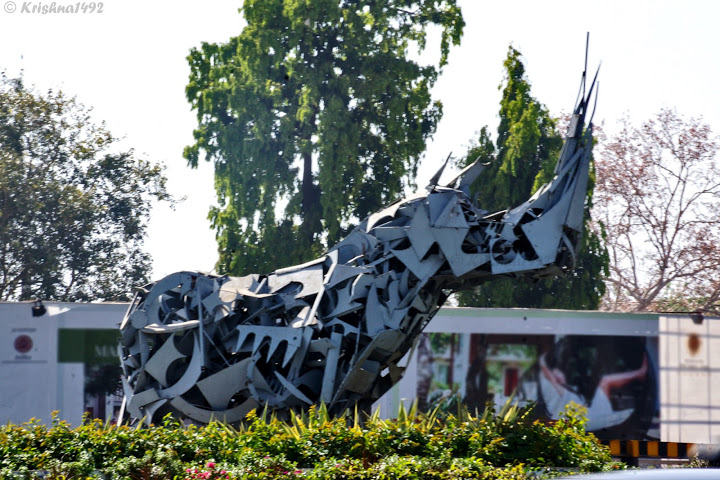
Rhino or Genda (word for rhino in Gujarati) circle.
At a busy road junction in the city is a circular traffic island. On this island is the structure of a rhinocerous made completely out of scrap iron pieces. The pieces were discarded by the SIECL (Sayaji Iron and Engineering Company Limited). Instead of dumping them in a land fill or recycling them, the city decided to make someting creative out of it. Hence the metal rhino.
Getting to Vadodara
Vadodara is one of the most connected cities in India. Let’s discuss the transport in the order from fastest to slowest.
Air
Vadodara airport is a well-served airport. The cities that have most connections to Vadodara are Mumbai and New Delhi. If you are unable to find a plane to Vadodara for your preferred timings, then look no further than Ahmedabad airport, which is less than 150 km away.
Rail
Vadodara is an important railway junction in Western Railway. Trains plying between Mumbai, New Delhi, Ahmedabad and Rajkot have to pass through Vadodara. Not only are there hundreds of trains to reach Vadodara, but there are also no less than 20 luxury super-fast trains. Scores of Rajdhanis, Shatabdis, Durontos and Hamsafars make a long 10-minute halt at Vadodara. Apart from trains from/to Mumbai, New Delhi and Ahmedabad, other trains that start from Kerala, coastal Karnataka or Goa and are bound for Gujarat, Rajasthan, Chandigarh, Haryana, Punjab and Jammu-Kashmir also ply through Vadodara. These trains need a 20-minute halt here for a locomotive change between electric and diesel.
Road
There are several overnight buses, both state and private, between Vadodara and Mumbai / Pune / Nashik in Maharashtra, Ratlam / Bhopal / Indore in Madhya Pradesh, Udaipur / Kota / Ajmer in Rajasthan. There are several shuttle super-fast buses that run the 110 km between Vadodara and Ahmedabad on the National Highway 8.
Self-drive
If you want to drive on your own, then take the Mumbai – New Delhi national highway NH-8. There are several interchanges to join this route wherever you are driving from the rest of India. Important cities on the route are Mumbai & Thane, Valsad, Navsari, Surat, Bharuch, Vadodara, Ahmedabad, Udaipur, Ajmer, Jaipur, Gurgaon and New Delhi. Any of these cities can be used to join this highway and proceed on your way to Vadodara.
Conclusion
The affluent city of Vadodara is more than just a business and a banking hub. The legacy of the Gaikwads and the subsequent hard work by the native Gujaratis means that Vadodara also flourishes as a beautiful, well laid-out and a planned city, with several tourist and recreational hot spots. Vadodara is worth a two to three days stay during your trip to Gujarat.

